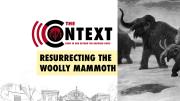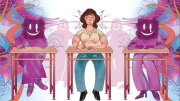This is the tenth post of "The Context"—a biweekly series of archival stories—offering our readers a useful background to some of the most important subjects in the news today. We hope you enjoy it.
What can you do these days with significant private funding and the latest advancements in synthetic biology? Possibly, thousands of years after the species went extinct, bring back the woolly mammoth.
A recent article in STAT highlighted the work of George Church, Winthrop professor of genetics at Harvard Medical School. For almost eight years, Church has been leading a team of researchers striving to bring back the woolly mammoth using CRIPSR gene-editing technology. Though the idea received significant news coverage when Church first publicly discussed the possibility in 2013, only recently did Colossal, a Texas-based artificial intelligence company, join with other funders to raise $15 million to support the project and make it a reality.
Church and his colleagues hope to edit the genome of Asian elephants to make them more resistant to cold temperatures and therefore able to push farther into the freezing tundra where mammoths once roamed. There, these cold-adapted elephants could knock down “dark, sunlight-absorbing trees” that are extending their range into the warming habitat and break up moss, “transforming the tundra into light-reflecting grassland that keeps the ground colder, locking in the methane and creating a lot of plant matter to lock up carbon, too.” This has the potential to help offset one of the dangerous, self-reinforcing cycles of climate change: a thawing tundra that releases gigantic quantities of greenhouse gases now trapped in the frozen, but rapidly warming, far north.
There are many questions about the practicality of the project. Will the species created present the desired traits? Would countries agree to host these tremendous creatures if Church’s group succeeds? And there are mammoth-sized ethical questions too. “Elephants are not just sentient creatures,” said David DeGrazia, a philosopher and bioethicist. “They’re really smart, they are really self-aware and emotionally complex. I don’t think we should involve them in experiments that are not in their best interest.”
At Harvard Magazine, we’ve written several articles about Church’s work and the implications of synthetic biology. In a recent feature story, managing editor Jon Shaw explored Church’s gene-editing work beyond the flashiest woolly mammoth headlines.
News accounts often report that he wants to revive the woolly mammoth….In fact, Church is undertaking a multi-pronged conservation project—with synthetic biology at its core—that he hopes will benefit living Asian elephants, humans, the Arctic, and perhaps the planet.
Aside from using gene editing to bring back an extinct species, Church also wants to edit the genome of living Asian elephants to make them resistant to pathogens like the endotheliotropic herpesvirus, which leads to hemorrhagic bleeding. This kind of editing, he believes, could aid in the survival of many threatened species—and improve immunotherapies for humans.
Shaw’s report also reveals business models Church has in mind for the genetically engineered mammoth: “you’ve got tourism, meat, hair…, and maybe legal ivory,” he says. Though this description presents ethical quandaries, Shaw writes that Church “is sanguine about the potential of biological engineering to make a better world.”
Another feature on Church’s work in synthetic biology from 2014 (before much of the mammoth publicity), also shows the extraordinary life-saving potential and moral pitfalls of the field. The author, Katherine Xue, described its promise this way:
Traditional genetic engineering amounted more or less to biological cut-and-paste: scientists could, for instance, transfer a cold-tolerance gene from an Arctic fish into a tomato. Synthetic biology aims for a more radical reorganization. Its organisms are built to be biological machines, with DNA and proteins standing in for circuit components or lines of computer code. In combination, the biological parts perform functions unknown to nature: processing signals, producing new chemicals, storing information.
The applications Xue presents include remodeling the human genome to detect and destroy all viruses. It’s an interesting and provocative analysis of the field.
For more on the topic, I’d recommend this article exploring former assistant professor of the history of science Sophia Roosth’s work on “de-extinction.” This review of Church’s research on creating a virus-resistant bacterium also provides more fundamental information on gene editing to understand his current projects.
More from “The Context”
- How the United States Can Cut Greenhouse-Gas Emissions: Our best articles on climate-change solutions
- The Gig Economy and the Future of Work: Our best work on employment's present and future
- Affirmative Action and Harvard: Recent and archival work on litigation in admissions
- Life on the Mesopotamian Marshes—and the Specter of Drought: Past work on water and human intervention
- How Exercise Gives Us Purpose: Reviewing our best articles on exercise
- Arthur C. Brooks on "Revenge Bedtime Procrastiination": Presenting our best archival work on sleep
- Universities Pushed to Reckon with Slavery: Students and activists advocate for institutional change.
- Simpsons Writer John Swartzwelder on Comedy: Sharing some of our best work on comedians and their craft
- Daniel Lieberman on Food Addiction: Framing the news with our best articles on diet and health









